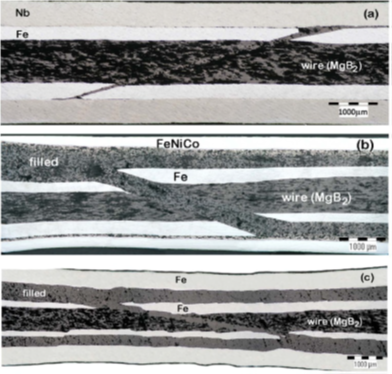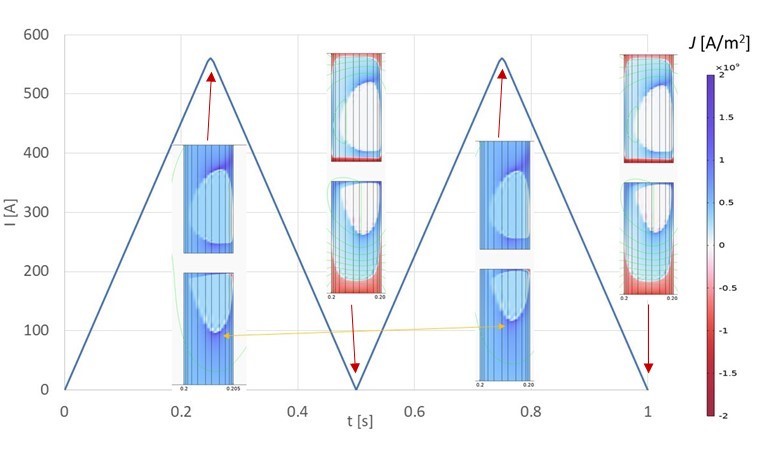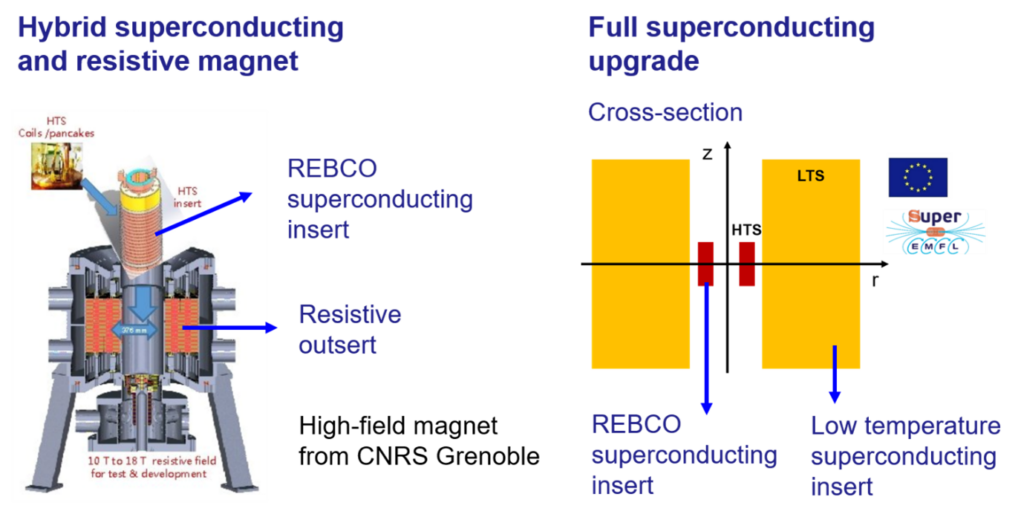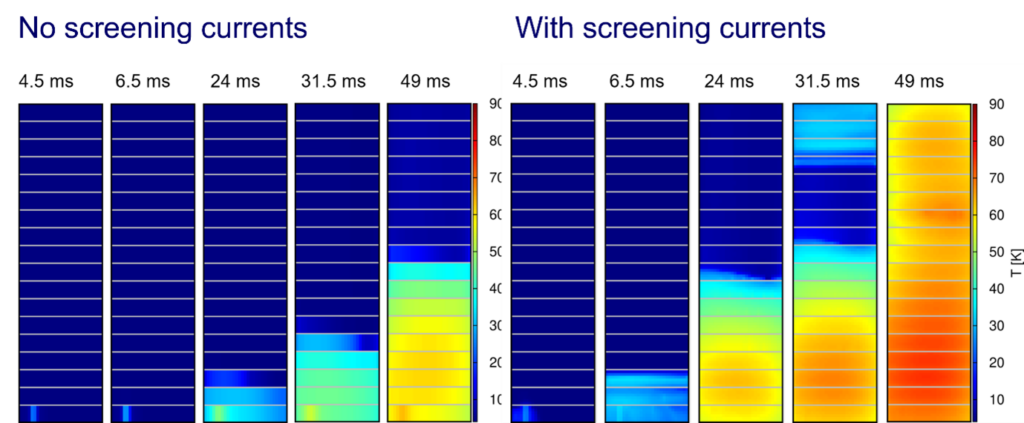2024
Superconducting joints between MgB2 wires
Authors: I. Hušek, P. Kováč, T. Melišek, D. Berek and L. Kopera, M Búran VEGA project 2/0017/22: Superconducting joints of MgB2 wires for windings in persistent mode
Effect of the interface angle and applied pressure on deformation, structure and transport current of joined single- and multi-core MgB2 wires were studied experimentally. The interfaces structure of joined in-situ [1], ex-situ [2]and IMD made[3] wires was analysed by optical microscopy. In-field transport currents up to 73 % of wire’s Ic were measured for joined single-core MgB2/Fe wires. In the case of 6-filament wires, the maximal transport current up to 53 % of wire’s Ic was reached. Presented results show that wires joined by presented technique could be potentially used for superconducting MgB2 coils in persistent mode.

- [1] I. Hušek, P. Kováč, T. Melišek, D. Berek and L. Kopera, Effect of interface angle, added powder and applied deformation on the structure and transport currents of joined single- and multi-core MgB2 wires, Supercond. Sci Technol. 37 (2024) 075016
- [2] T. Melišek, D. Berek, M. Búran, M. Bennar and P. Kováč, Properties of termination joined ex-situ MgB2 wires, Cryogenics 141(2024) 103857
- [3] I. Hušek, P. Kováč, T. Melišek and M. Hain, Transport currents and micro-structure of superconducting joint between MgB2/Ni and MgB2/Nb wires made by IMD process, Ceramics International, Volume49 issue 7 (2023) 11178
Feasibility study of the replacement of copper wire in accelerator magnet by a high-temperature superconductor
Authors: F. Gömöry, M. Soloviov
Customer: GSI Darmstadt (Germany)
The electromagnets used in the heavy ion accelerator SIS-18 located in GSI Darmstadt have been wound using metallic Cu wires. Ohmic losses inevitably present at generating required magnetic field signify a non-negligible contribution to the energy consumption during the machine operation, that became critical recently due to increasing cost of electricity. We performed theoretical study aimed at one-to-one replacement – keeping the same number of turns and waveform of electrical current – of the Cu winding by the coil from high-temperature superconductor tape. In the first step, simplified semi-analytical approach was utilized to identify the suitable range of operating temperatures and preliminary estimation of dissipation during current ramp. Then, for a limited set of designs, full temperature dependent computation assuming detailed characterization of transport capability of superconducting material was performed. We have found, that the simplified analytical approach provided correct guidance towards optimization of the coil winding arrangement.

A novel and fast software for multi-physics quench analysis in high field magnets
Authors from IEE SAS: E Pardo, A Dadhich, AK Srivastava, A Hussain
European Horizon2020 project: superEMFL, contract number 951714
COST action: Hi-SCALE, contract number CA19108
High temperature superconducting (HTS) electro-magnets enable static magnetic fields as high as 40 T. This opens the possibility to measure key properties of novel materials in many fields, from clean energy to novel medicines. The European Horizon2020 project superEMFL aims to design two of these magnets, which generate 32 and 40 T, respectively. Magnet design is complex due to the interplay between screening currents, temperature increase, and mechanical stress. For instance, heating due to screening or radial currents can induce electro-thermal quench, which also causes thermal stress. Therefore, magnet analysis requires multi-physics modelling and needs to be as fast as possible for magnet design. Although 3D modeling provides the full description, it is highly time consuming. In this work, we propose a fast and accurate cross-sectional 2D method for multi-physics modelling for the electromagnetic-thermal-mechanical behavior of the magnet that takes screening currents into account. The method reciprocally couples our electromagnetic software (MEMEP [1]) a method that we developed, based on finite differences [3] . In particular, we study the self-heating effects during ramp and the electro-thermal quench due to a damaged turn that suddenly appears at the current plateau. Additionally, we benchmark the electro-thermal model with those used in several groups around the world that participate in the COST action Hi-SCALE, as mutual verification. Our results show that electro-thermal quench propagates electromagnetically through changes in the screening currents, rather than thermal diffusion. This causes fast quench propagation, being a few milliseconds in some cases. In addition, we analyze the stress increase due to screening currents and the local stresses caused by thermal expansion during electro-thermal quench. In conclusion, our modelling method is suitable for multi-physics design of high-field magnets.

(Right) Full superconducting magnets drastically reduce consumption because of zero superconducting resistance.

- [1] Pardo, E. and Fazilleau, P.: Fast and accurate electromagnetic modeling of non-insulated and metal-insulated REBCO magnets, Supercond. Sci Technol. 37 (2024) 035016. IF 3.7, 5 citations excluding self-citations.
- [2] Dadhich, A., Fazilleau, P., and Pardo, E.: A novel and fast electromagnetic and electrothermal software for quench analysis of high field magnets, Supercond. Sci Technol. 37 (2024) 095024. IF 3.7.
- [3] Srivastava, A.K. and Pardo, E.: Modelling the mechanics of 32 T REBCO superconductor magnet using numerical simulation, Supercond. Sci Technol. 37 (2024) 075014. IF 3.7.
- [4] Dadhich, A., Grilli, F., Dennis, L., Vanderheyden, B., Geuzaine, C., Trillaud, F., Sotnikov, D., Salmi, T., Hajiri, G., Berger, K., Benkel, T., dos Santos, G., Santos, B.M.O., Martins, F.G.R., Hussain, A., and Pardo, E.: Electromagnetic-thermal modeling of high-temperature superconducting coils with homogenized method and different formulations: a benchmark, Supercond. Sci Technol. 37 (2024) 125006. IF 3.7.





